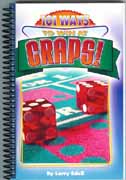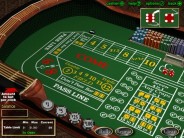
101 Ways to Win at Craps
Ten major chapters (plus a glossary, resources page and index) cover the entire range of craps play. Each chapter is divided into ten sections. For example, the Pass and Come Methods includes information on how to make odds-only bets; betting before the come out; making money with place bets; pushing the house; making money with come bets; protecting your pass line bet; betting don't; multiple odds table; remembering odds; making money on a cold table.
The book also includes $50 worth of free coupons.
Craps Pro Secrets of Fours and Tens
Most place bettors seem confident that the best place bet is the 6 or 8.
This bet pays 7:6, that is when you bet $30, you'll Larry Edell has been the editor of 'The Crapshooter Newsletter' since 1994. He has published nine books and over two hundred different articles in magazines such as 'Casino Player', 'Gaming Today', 'Mid West Players 'and 'Gambling Times'. Larry's website is www.thecrapshooter.com win $35.
Larry Edell has been the editor of 'The Crapshooter Newsletter' since 1994. He has published nine books and over two hundred different articles in magazines such as 'Casino Player', 'Gaming Today', 'Mid West Players 'and 'Gambling Times'. Larry's website is www.thecrapshooter.com win $35.
Some people place bet both numbers together, increasing their chances of winning, but at the same time, exposing their money to more risk. If the seven rolls, you're out $60 (2 x $30), which means you have to win twice more just to get ahead.
The seven should roll six times in 36 rolls, and the combination of the 6 and 8 should roll ten times (five times each). So, in 36 rolls, you should win 10 times (at $35) and lose six times (at $60). This turns out to be a net loss of $10 ($350-$360).
Not too bad, really, considering all the comps you'll be getting while you're playing the sixes and eights. But are there any other numbers that we can bet on which could provide even a more profitable win than the six and eight?
Wanna know the secret that craps pros use to get better odds than the 6 and 8 offers? Let's find out.
In 36 rolls, the four and ten combination should roll six times (three each), the same amount as the seven. By betting $25 on both the four and ten, you should win six times (6 x $45) and lose six times (6 x $50), resulting in a net loss of $30 ($270-$300).
However, there are some special circumstances surrounding these numbers.
The four and ten can be bought for a 5% commission. In addition, some casinos only charge this "vig" if you win. And finally, that 5% commission is usually only $1 on a $25 bet (instead of $1.25) to obtain true odds, or 2:1 (instead of 9:5) for your bets.
This means that if you buy the four and ten and win either number, you'll get $50 (at 2:1) instead of $45 (at 9:5).
As previously mentioned, by placing the 6 & 8 you might lose $10 in 36 rolls. By buying the 4 & 10, you should win six times if either the four or ten hit, at 2:1 odds (6 x $50 = $300). You might also lose six times if the seven rolls, losing both of your bets (6 x $50 = $300), resulting in an exactly even proposition, not counting the vigs.
If you play in a casino that only collects the vigs when you win, you'll only lose $6 in vigs for six wins, which is $4 less than you'd lose by placing the six or eight.
And by buying both the four and ten, you'll get higher comps, and have a slightly lower risk.
And now an even larger difference between the 4 & 10 and the 6 & 8 becomes evident.
If you place the 6 & 8 for $30 each and lose (2 x $30 = $60), you'll need to win twice more just to get ahead (2 x $35 = $70, at 7:6).
However, if you buy the 4 & 10 for $25 each and lose (2 x $25 = $50), you'll need to win just once more (2 x $25 = $50, at 2:1) to break even!
More and more crapshooters are trying this play, especially in casinos that only charge the vig on winning bets. So, the next time you think of placing the 6 and 8, try buying the 4 and 10 instead!
Pssst...! Now you know the secrets of betting on the 4's and 10s!

